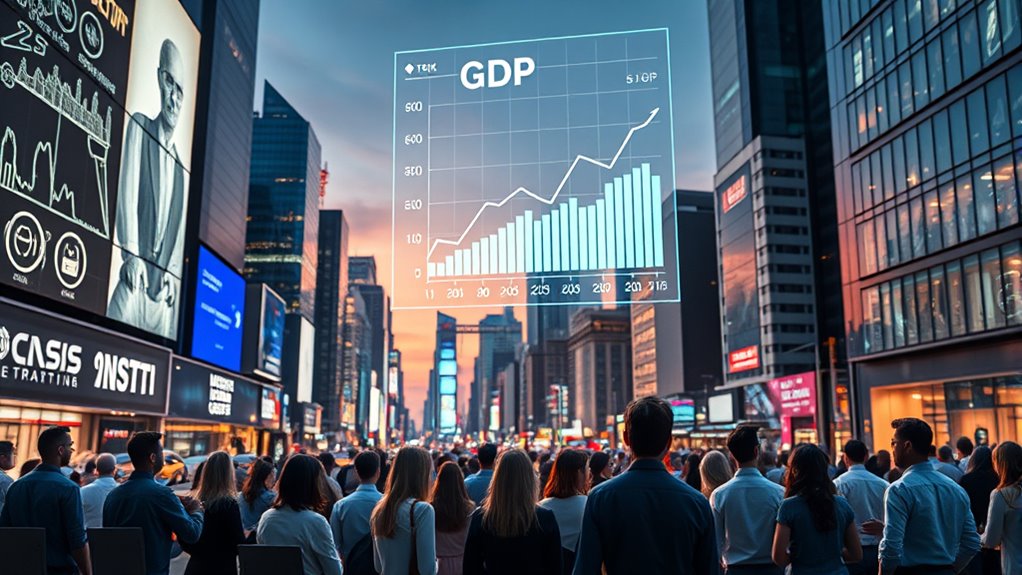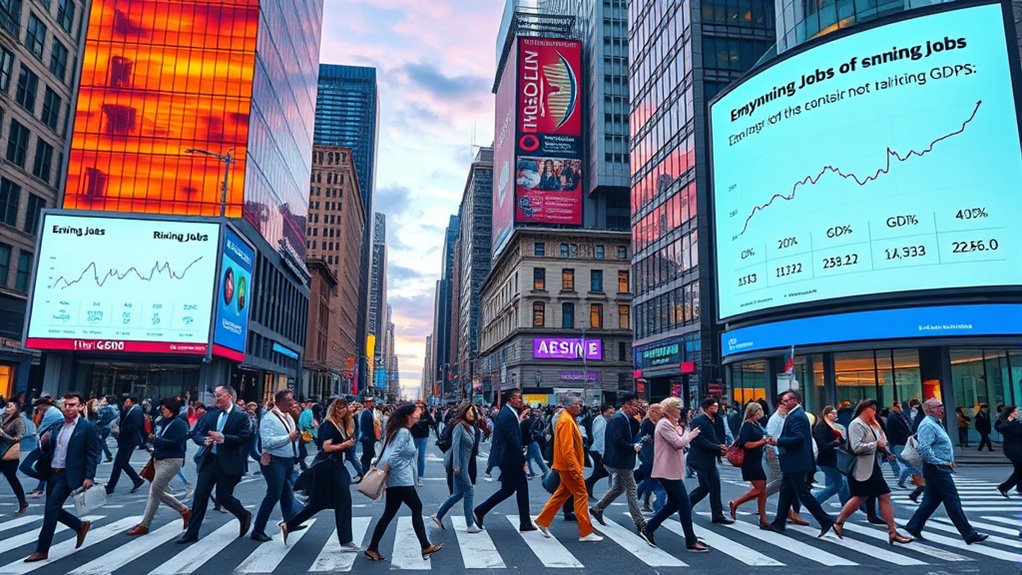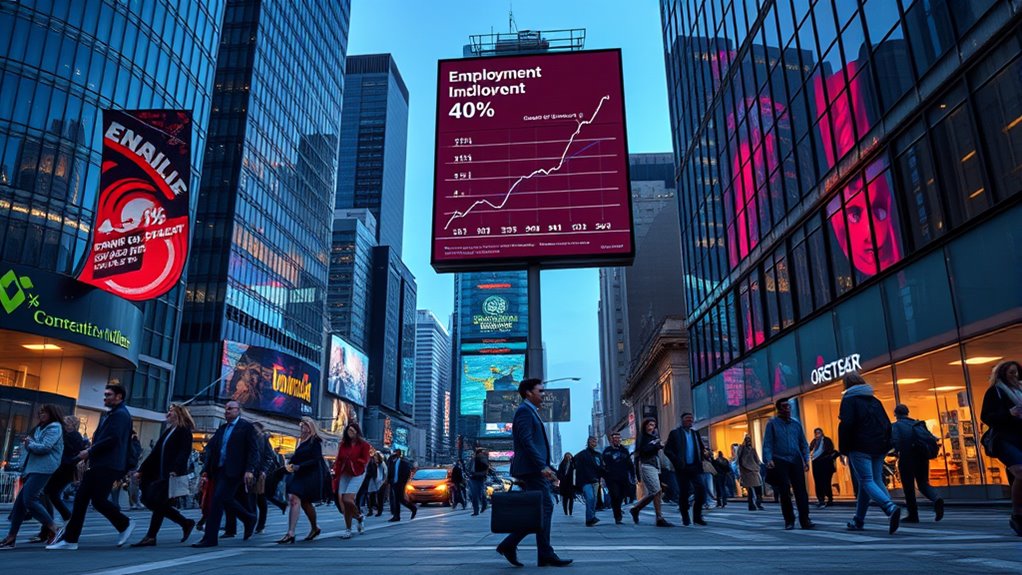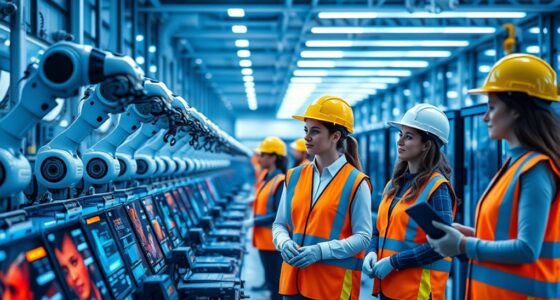Despite concerns about widespread job cuts, the global economy is expected to grow, with GDP surging while employment may decline markedly—up to 40%. Automation, AI, and structural shifts are driving this divergence, as many sectors see productivity gains without adding jobs. If you want to understand how to navigate this uncertain future, including skills needed and policy changes, there’s much more to contemplate.
Key Takeaways
- AI and automation could displace up to 85 million jobs globally by 2025, with significant impacts on routine and white-collar roles.
- Despite job cuts, global GDP is expected to grow by approximately 2.8% in 2025, indicating economic expansion amid employment shifts.
- Technological innovations and industry restructuring may lead to a 40% reduction in certain job categories, especially in manufacturing and finance sectors.
- New opportunities in tech, healthcare, and green industries are emerging, requiring reskilling and adaptation among workers.
- The economy’s resilience depends on workforce upskilling, policy support, and the development of new roles to offset employment declines.
Projected Trends in the Global Labor Market

Despite recent setbacks, the global labor market shows signs of cautious resilience. You’ll notice that the International Labour Organization (ILO) has revised down employment growth for 2025 from 1.7% to 1.5%, forecasting about 7 million fewer jobs. Overall, around 53 million new jobs are expected globally, slightly less than earlier predictions of 60 million. Meanwhile, GDP growth projections for 2025 have been lowered from 3.2% to 2.8%, which dampens job creation prospects. Despite these challenges, the unemployment rate remains low at approximately 5%, signaling persistent labor market tightness. Long-term, employment is expected to grow by around 7% from 2025 to 2030. These figures suggest that while growth slows, the job market continues to create opportunities amid ongoing structural shifts, especially as cybersecurity becomes increasingly vital in protecting digital infrastructure.
The Role of Artificial Intelligence in Job Displacement

Artificial intelligence is fundamentally reshaping the workforce, accelerating job displacement across various sectors. You’ll see AI automating tasks in industries like manufacturing, tech, and finance, leading to significant job losses. For example, about 50 million U.S. jobs could be affected soon, with 77,999 tech roles lost since early 2025. Entry-level and white-collar jobs are especially vulnerable, with many positions either removed or transformed to AI-assisted roles. Globally, up to 85 million jobs may be replaced by AI by 2025, and by 2030, 30% of U.S. jobs could be fully automated. You should also consider that a growing number of workers fear losing jobs to AI, which amplifies economic and social challenges. The impact of AI on entry-level jobs is particularly severe, with many roles being eliminated or requiring significant skill shifts.
AI is rapidly transforming jobs worldwide, displacing millions in manufacturing, finance, and tech sectors.
- AI is replacing routine and manual tasks, speeding up manufacturing job losses.
- White-collar roles in finance, law, and tech face significant automation threats.
- Many workers perceive AI as devaluing traditional education for employment.
- Companies increasingly favor automation over human labor, boosting displacement.
Structural Shifts and Emerging Opportunities (2025–2030)

As the labor market transforms between 2025 and 2030, you’ll see new job opportunities emerge alongside significant industry shifts driven by technology, climate change, and demographics. You’ll need to develop new skills for high-demand roles in tech, healthcare, and essential services, while adapting to the decline of routine jobs. Staying flexible and investing in retraining will be vital to steering through these structural changes successfully. Demographic shifts will further influence sectoral growth, requiring workers to be adaptable across different industries. Additionally, advancements in home entertainment technology, such as projectors and audio systems, will create opportunities in related fields like consumer electronics and installation services.
Job Creation in Tech
Between 2025 and 2030, the tech industry will experience significant structural shifts that drive job creation across emerging categories. You’ll see rapid growth in areas like AI governance, cybersecurity, and green tech, creating millions of new roles. Despite recent market volatility, AI’s impact is expected to generate up to 50 million jobs globally, boosting overall employment. New opportunities will arise in AI oversight, data analysis, and sustainable technology, shaping the future workforce. You should also note that many of these roles will require advanced skills, such as data literacy and critical thinking. The shift toward tech-driven sectors will balance displacement with substantial net job growth, fueling economic expansion. Additionally, the increasing adoption of vetted portable camping gear like solar panels and portable power banks will support outdoor professionals and enthusiasts, fostering innovation and new employment opportunities in outdoor tech markets.
Skills for Future Work
How will you prepare for the evolving workforce landscape from 2025 to 2030? You’ll need to focus on mastering AI, big data, cybersecurity, and digital literacy to stay relevant. But technical skills alone won’t suffice; soft skills like creativity, analytical thinking, resilience, and curiosity will be equally crucial. Developing leadership, social influence, and systems thinking will enhance your value in complex, hybrid teams. Sustainability and environmental skills will grow in importance, aligning with the green transition. Since nearly 39% of current skills will become outdated by 2030, embracing lifelong learning and reskilling is essential. You’ll benefit from personalized, flexible training options—online courses, modular programs—that foster continuous growth. Adapting to digital work, remote collaboration, and managing digital wellbeing will also be key to thriving in this new era. Additionally, understanding educational data mining and their impact on job markets will help you navigate future opportunities and challenges effectively.
Market and Industry Shifts
From 2025 to 2030, market and industry landscapes will undergo significant structural shifts driven by technological innovations, geopolitical changes, and evolving energy policies. You’ll see industries transforming rapidly, with AI, robotics, and energy tech reshaping business models and demand. While the U.S. focuses on expanding gas-fired power plants, the EU invests heavily in offshore wind, aiming for 120 GW capacity by 2030, reducing fossil fuel reliance. Emerging markets in Asia grow strongly, but trade restrictions could challenge investments and stability. These shifts will create new opportunities but also uncertainties, especially around market volatility and regional divergence. Global GDP growth is expected to be 3.3% in 2025 and 2026, which may influence investment flows and economic stability worldwide. Additionally, the adoption of renewable energy technologies and infrastructure will accelerate, creating opportunities for innovation and sustainable growth. Increased regional economic divergence and investment patterns are likely to emerge as countries pursue different energy and market strategies. Growth in green jobs linked to climate adaptation efforts will contribute to economic resilience, but disruptions caused by geopolitical tensions and trade restrictions may pose risks to global stability.
Disentangling Economic Growth and Employment Dynamics

Disentangling the relationship between economic growth and employment requires recognizing that their connection isn’t always straightforward or proportional. While GDP growth generally boosts employment, the strength of this link varies by country, sector, and time. In the U.S., a 1% increase in GDP typically results in about a 0.47% rise in employment, but this lag can be several quarters. Higher productivity can weaken this elasticity, as firms meet demand without adding jobs. In mature economies, growth from technology and capital-intensive sectors often expands GDP without proportionate job gains. Additionally, in developing countries with large informal sectors, employment growth tends to lag behind GDP expansion. Sectoral shifts and automation increasingly decouple economic growth from employment, complicating efforts to predict job market trends amid rising GDP. Recognizing the role of technological advancements is crucial, as they can significantly influence employment patterns independent of overall economic growth.
Recession Risks and Their Potential Impact on Jobs

Despite mixed signals in the economy, recession risks are mounting, and their potential impact on jobs remains uncertain. You’re seeing indicators like declining consumer confidence and negative GDP growth, yet the labor market stays resilient, with April adding 177,000 jobs. Unemployment claims are up, but stay low historically, and layoffs are increasing in both public and private sectors. Economists predict unemployment could rise to around 4.3%–4.5%, with slower job growth expected. However, most still anticipate net job creation, and sectoral differences show growth in health care, transportation, and finance, while government jobs decline. The current unemployment rate is 4.2%, key factors to watch include:
Mixed economic signals suggest recession risks are rising amid resilient job growth and sectoral shifts.
- Sector-specific vulnerabilities
- Policy impacts on employment
- Labor force growth from immigration
- The disconnect between GDP and jobs
Corporate Strategies for Workforce Transformation

To stay competitive, you need to prioritize upskilling and reskilling initiatives that prepare your workforce for rapid technological change. Embracing automation and AI can boost efficiency but requires strategic workforce restructuring to adapt roles and hierarchies. By focusing on these strategies, you can build a flexible, skilled team ready for the future of work. Incorporating personality insights, such as understanding diverse behavioral traits, can further enhance team dynamics and leadership effectiveness.
Reskilling and Upskilling Initiatives
As technology continues to advance rapidly, companies are implementing extensive reskilling and upskilling initiatives to stay competitive. You need to adapt quickly as 50% of employees will require reskilling by 2025, and core skills are projected to change by 44% by 2027. To meet this demand, organizations are investing in large-scale programs like Amazon’s £1.2 billion Career Choice, in-house platforms, and microcredentialing in areas like cybersecurity and cloud computing. Partnerships with online providers and community colleges expand access. Prioritized skills include technical fluency, emotional intelligence, and sustainability knowledge. Engagement techniques such as microlearning, personalized AI platforms, and incentive-based learning keep employees motivated. These initiatives foster workforce agility, reduce hiring costs, and support continuous development amid evolving workforce needs. Additionally, understanding the personality traits of employees can help tailor effective training strategies, ensuring better engagement and skill retention.
Workforce Restructuring Strategies
Workforce restructuring strategies are key to helping organizations adapt to rapid technological change and shifting market demands. You can optimize your structure by centralizing support functions, consolidating roles, and building Global Business Services to standardize processes and boost efficiency. Simplifying or merging roles that no longer align with strategic goals or are automated reduces redundancy. Reassessing the span of control and organizational layers improves agility and decision speed. Data-driven talent matching ensures the right people are placed in new roles based on skills and performance, supporting internal mobility. Strategic workforce planning involves identifying future skills, proactively managing labor market shifts, and shifting from traditional job descriptions to skills-based frameworks. These measures help you redeploy internal talent, reduce disruption, and maintain competitive advantage. Workforce analytics can provide valuable insights to identify skills gaps and inform strategic decisions during restructuring. Incorporating skills-based frameworks allows organizations to better match talent to evolving roles and technological requirements, facilitating smoother transitions and future readiness.
Embracing Automation and AI
Embracing automation and AI is transforming how organizations manage their human resources, driving efficiency and competitive advantage. You’re likely to see more companies integrating AI into HR workflows, with 80% expected to do so by 2025. Many organizations are investing heavily in AI, although only 1% feel their implementation is fully mature. HR professionals generally view AI positively, recognizing its impact on operations. To stay ahead, businesses focus on reskilling employees and hiring talent with AI expertise. Integrating industry-specific knowledge, such as Honda Tuning, can also provide companies with specialized insights to optimize workforce strategies.
- Prioritizing continuous learning to keep pace with evolving AI tools
- Developing strategies for workforce reskilling and upskilling
- Using AI to enhance decision-making and operational efficiency
- Managing job displacement risks while leveraging AI’s productivity benefits

Charting the future of work requires proactive strategies that prioritize skills development, effective policies, and organizational adaptation. You’ll need to focus on building digital literacy, AI understanding, cybersecurity, and creative problem-solving to stay relevant. Skills-based hiring is replacing traditional degrees, so continuous learning and flexibility are essential. Governments and companies must collaborate on targeted training programs, especially to reduce youth unemployment and bridge skills gaps. Organizations should audit workflows to find opportunities for human-AI collaboration instead of replacement. As remote and flexible work become standard, developing adaptable work arrangements will be vital. Green transition policies also demand new skills, emphasizing sustainability and emissions reduction. By embracing these shifts, you can better navigate job disruptions and seize emerging opportunities in the evolving economy. Rapid technological change means that 44% of workers will need reskilling or upskilling within five years, highlighting the urgency of continuous education for workforce resilience.
Frequently Asked Questions
How Will Remote Work Influence Future Employment Trends?
Remote work will markedly shape future employment trends by expanding opportunities and increasing flexibility. You’ll find more jobs accessible from anywhere, attracting a wider talent pool. As hybrid and fully remote roles become common, you’ll see improved retention and work-life balance. Companies will continue to adapt, offering flexible arrangements that help them stay competitive. Overall, remote work won’t replace traditional jobs but will transform how you work and where you work from.
What Policies Can Mitigate Ai-Driven Job Displacement?
Think of the job market as a shifting landscape, where AI reshapes the terrain. To navigate this, you should push for policies that fund retraining programs, ensuring workers develop new skills before being left behind. Advocate for portable health benefits and social safety nets that follow workers across job changes. Support taxes on AI profits to finance these initiatives, helping you and others ride the waves of technological change without capsizing.
Which Sectors Will Benefit Most From Technological Shifts?
You’ll find that technology shifts benefit sectors like AI-driven healthcare and finance, where automation and advanced analytics improve efficiency and innovation. Semiconductor and hardware manufacturing will thrive due to demand for AI chips, while extended reality (XR) transforms remote operations and training. Sustainable tech and quantum computing also gain momentum, creating new opportunities. By embracing these changes, you can position yourself in high-growth areas that drive economic progress and offer new career prospects.
How Might Global Trade Changes Affect Employment Opportunities?
You might see employment opportunities shift as global trade changes. Some sectors, like manufacturing, could grow due to tariffs, but others, like agriculture and services, may decline. Trade disruptions can cause regional job losses and create new openings in tech, cybersecurity, and green energy. You’ll need to adapt by developing skills in resilience, flexibility, and tech, as the job market transforms with shifting trade policies and global economic dynamics.
What Skills Will Be Most Valuable in the Evolving Job Market?
Picture a river of change flowing swiftly; you’ll want to swim, not sink. In this evolving job market, you’ll find data literacy, AI skills, and technological fluency as your oars to stay afloat. Creative thinking, emotional intelligence, and adaptability are your compass and map, guiding you through turbulent waters. Mastering problem-solving and continuous learning will keep you ahead, ensuring you navigate the future’s currents with confidence and resilience.
Conclusion
As you stand at this crossroads, remember that the storm of job cuts is like a tempest clearing the old forest. Beyond the chaos, new growth awaits—skills rooted in innovation and resilience. Embrace this season of change as a phoenix rising from the ashes, soaring toward opportunities that reshape your future. The horizon promises not just uncertainty, but a dawn where your adaptability becomes the guiding star leading you to brighter days.









